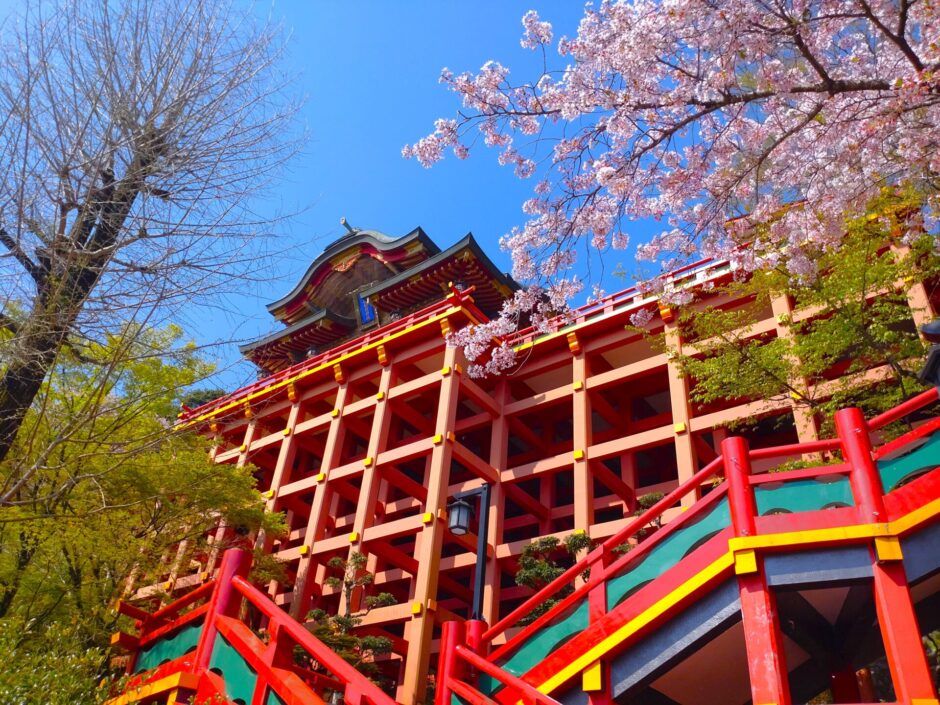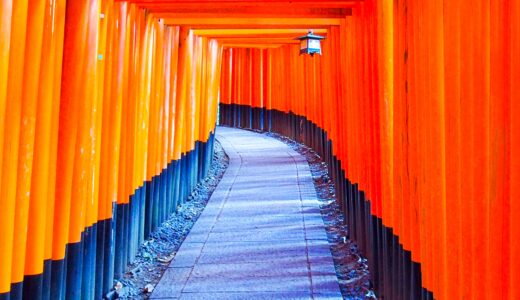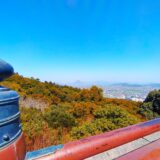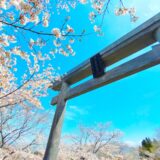目次
- 【Yutoku Inari Shrine Summary】
- 【Yutoku Inari Shrine Road approaching a shrine】
- 【Yutoku Inari Shrine Yangming Gate】
- 【Yutoku Inari Shrine Hall of worship】
- 【Yutoku Inari Shrine Okunoin】
- 【Kashima Akira Shrine (outer garden of Yutoku Inari Shrine)】
- 【Yutoku Inari Shrine Access】
- Manager’s Comments
- Yutoku Inari Shrine
【Yutoku Inari Shrine Summary】
Yutoku Inari Shrine was built in 1687 (Jokyo 4) in the early Edo period. The shrine was built in 1687 (Jokyo 4) in the early Edo period (1603-1867) by Hanayama-in Manko- Ehime, the wife of Nabeshima Naocho, feudal lord of Kashima, Hizen, and was dedicated to the deity Inari, which was an imperial shrine of the Imperial Court. The shrine is said to be visited by as many as 3 million worshippers a year, who pray for prosperity of business, prosperity of the family, satisfaction from a big catch, traffic safety, and so on.
![Yutoku Inari Shrine [Saga] DSC 3498 1024x768 - Yutoku Inari Shrine [Saga]](https://japan-shrine.info/wp-content/uploads/DSC_3498-1024x768.jpg)
One of the three major Inari shrines in Japan (according to various theories), it is the second most visited shrine in Kyushu after Dazaifu Tenmangu Shrine in Fukuoka.
【Yutoku Inari Shrine Road approaching a shrine】
![Yutoku Inari Shrine [Saga] DSC 3501 1024x768 - Yutoku Inari Shrine [Saga]](https://japan-shrine.info/wp-content/uploads/DSC_3501-1024x768.jpg)
In spring, cherry blossoms bloom on both sides of the approach. The approach to the temple is a pleasant place to walk, with a variety of stores, some of which retain a Showa-era atmosphere and others that are more modern.
![Yutoku Inari Shrine [Saga] DSC 3562 1024x768 - Yutoku Inari Shrine [Saga]](https://japan-shrine.info/wp-content/uploads/DSC_3562-1024x768.jpg)
The approach from the prefectural road is through the sacred bridge over the Nishikinami River.
![Yutoku Inari Shrine [Saga] DSC 3504 1024x768 - Yutoku Inari Shrine [Saga]](https://japan-shrine.info/wp-content/uploads/DSC_3504-1024x768.jpg)
As is typical of Inari shrines, there is a fox guardian dog in front of the torii gate. It is holding an ear of rice in its mouth.
【Yutoku Inari Shrine Yangming Gate】
![Yutoku Inari Shrine [Saga] DSC 3508 1024x768 - Yutoku Inari Shrine [Saga]](https://japan-shrine.info/wp-content/uploads/DSC_3508-1024x768.jpg)
The tower gate is said to be modeled after the Yomeimon gate of Nikko Toshogu Shrine. After passing through the gate, the main shrine building is right in front of you. The main shrine of Yutoku Inari Shrine is located on a hillside 18 meters above the ground, making it an overwhelmingly large structure.
【Yutoku Inari Shrine Hall of worship】
![Yutoku Inari Shrine [Saga] DSC 3510 1024x768 - Yutoku Inari Shrine [Saga]](https://japan-shrine.info/wp-content/uploads/DSC_3510-1024x768.jpg)
The hall of worship is located on a turret reminiscent of the stage of Kiyomizu, with 117 steps leading up to the top. For those who are not confident with their legs, there is an elevator for a fee (300 yen with amulet).
![Yutoku Inari Shrine [Saga] DSC 3515 1024x768 - Yutoku Inari Shrine [Saga]](https://japan-shrine.info/wp-content/uploads/DSC_3515-1024x768.jpg)
The overall bright vermilion precincts are very eye-catching and beautiful. The vermilion color in the clear sky is also indescribable. The shrine pavilions are painted in a variety of colors and are said to be called “Chinsei-Nikko. The carvings in the shrine pavilions are carefully done, and the ceiling paintings and decorations on the vermilion-lacquered pillars are wonderful.
![Yutoku Inari Shrine [Saga] DSC 3518 1024x768 - Yutoku Inari Shrine [Saga]](https://japan-shrine.info/wp-content/uploads/DSC_3518-1024x768.jpg)
【Yutoku Inari Shrine Okunoin】
![Yutoku Inari Shrine [Saga] DSC 3526 1024x768 - Yutoku Inari Shrine [Saga]](https://japan-shrine.info/wp-content/uploads/DSC_3526-1024x768.jpg)
The approach to Okunoin is not as steep as that to Fushimi Inari in Kyoto, but it has a beautiful view of the thousand torii gates.
![Yutoku Inari Shrine [Saga] DSC 3528 1024x768 - Yutoku Inari Shrine [Saga]](https://japan-shrine.info/wp-content/uploads/DSC_3528-1024x768.jpg)
However, as the “warning” at the top of the climb states, “Please refrain from climbing Okunoin if you are not in good physical condition. It is not recommended for people with weak legs and feet or those wearing heels. It is especially dangerous on rainy days, so take it easy.
![Yutoku Inari Shrine [Saga] DSC 3532 1024x768 - Yutoku Inari Shrine [Saga]](https://japan-shrine.info/wp-content/uploads/DSC_3532-1024x768.jpg)
From Okunoin vista, you can see all the way to the Ariake Sea, which is very spectacular.
![Yutoku Inari Shrine [Saga] DSC 3530 1024x768 - Yutoku Inari Shrine [Saga]](https://japan-shrine.info/wp-content/uploads/DSC_3530-1024x768.jpg)
【Kashima Akira Shrine (outer garden of Yutoku Inari Shrine)】
As can be seen from the view, there are beautiful cherry blossoms across from the Yutoku Inari Shrine, but this is the outer garden of the Yutoku Inari Shrine.
![Yutoku Inari Shrine [Saga] DSC 3552 1024x768 - Yutoku Inari Shrine [Saga]](https://japan-shrine.info/wp-content/uploads/DSC_3552-1024x768.jpg)
It is a plaza with a fountain and a nice view. However, it is deserted because most visitors are there to worship at the Yutoku Inari Shrine.
![Yutoku Inari Shrine [Saga] DSC 3555 1024x768 - Yutoku Inari Shrine [Saga]](https://japan-shrine.info/wp-content/uploads/DSC_3555-1024x768.jpg)
There is a torii gate next to the fountain plaza. A little further up is the Kashima-Myo Shrine.
![Yutoku Inari Shrine [Saga] DSC 3556 1024x768 - Yutoku Inari Shrine [Saga]](https://japan-shrine.info/wp-content/uploads/DSC_3556-1024x768.jpg)
It seems that the lord was originally the founder of the Kashima Clan and enshrined a branch spirit of the Kashima Jingu Shrine, which he believed in. This area is now the city of Kashima, and the shrine seems to have taken its name from it. The deity is Takemikazuchi of Kashima Jingu Shrine.
![Yutoku Inari Shrine [Saga] DSC 3558 1024x768 - Yutoku Inari Shrine [Saga]](https://japan-shrine.info/wp-content/uploads/DSC_3558-1024x768.jpg)
From the garden, you can see Yutoku Inari Shrine across the street, and the view from here is also nice.
【Yutoku Inari Shrine Access】
Manager’s Comments
The vermilion torii gateway through the mountains, the stalls that entertain visitors, the quiet front path, and the magnificent shrine pavilion overhead are all picturesque and wonderful. I think it is the top tourist attraction in Saga. The cherry blossom season is especially wonderful and I would love to visit the shrine with my family. However, there are not many tourist attractions around the shrine, so I felt it was necessary to plan with this in mind.
1855 Furueda-Otsu, Kashima City, Saga 849-1321
※Free parking available
 Tour of Japanese shrines and temples
Tour of Japanese shrines and temples 


![Yutoku Inari Shrine [Saga] DSC 2572 150x150 - Yutoku Inari Shrine [Saga]](https://japan-shrine.info/wp-content/uploads/DSC_2572-150x150.jpg)
![Yutoku Inari Shrine [Saga] DSC 0082 1 150x150 - Yutoku Inari Shrine [Saga]](https://japan-shrine.info/wp-content/uploads/DSC_0082-1-150x150.jpg)
![Yutoku Inari Shrine [Saga] DSC 0135 150x150 - Yutoku Inari Shrine [Saga]](https://japan-shrine.info/wp-content/uploads/DSC_0135-150x150.jpg)
![Yutoku Inari Shrine [Saga] 25754802 m 150x150 - Yutoku Inari Shrine [Saga]](https://japan-shrine.info/wp-content/uploads/25754802_m-150x150.jpg)

